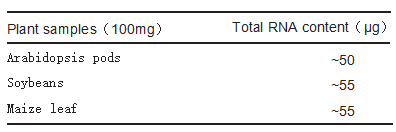Determine the necessary mass, volume, or concentration for preparing a solution.
Basic Description
| Storage Temp | Store at -20°C | |||||||||||||||||||||||||||||||||||||||||
|---|---|---|---|---|---|---|---|---|---|---|---|---|---|---|---|---|---|---|---|---|---|---|---|---|---|---|---|---|---|---|---|---|---|---|---|---|---|---|---|---|---|---|
| Shipped In | Ice chest + Ice pads | |||||||||||||||||||||||||||||||||||||||||
| Product Description |
Product Introduction This kit is suitable for extracting RNA from a wide range of plants, even from plants rich in polysaccharides and polyphenols, high quality RNA can be successfully extracted, such as rice leaves, wheat leaves, corn leaves, tobacco leaves, pine needles, ginkgo leaves, poplar leaves, pomegranate leaves, holly leaves, apples, peaches, pears, tomatoes, cherries, apricots, bananas, grapes, loquats, cinnamon rinds, cinnamon pulp, lychee fruit rinds, lychee pulp, soybean, peanut, corn, potato tuber, moonflower petal, pomegranate petal, shiitake mushroom, flat mushroom and other samples. The unique lysate formula can rapidly inactivate the RNA enzyme in the cell, effectively remove the effect of polysaccharide and polyphenol on RNA extraction, without the need for phenol, chloroform and other reagents, while using silicon matrix membrane adsorption of RNA for purification, the total RNA extracted is highly pure, without the contamination of genomes, proteins and other impurities, and can be used for Real Time RT-PCR, RT-PCR, It can be used for Real Time RT-PCR, RT-PCR, Northern Blot, Dot Blot, in vitro translation and other downstream experiments. Self-contained reagents: β-mercaptoethanol, anhydrous ethanol (freshly opened or for RNA extraction) Pre-experiment Preparation and Important Notes 1. To prevent RNase contamination, attention should be paid to the following aspects: 1) Use RNase-free plastics and tips. (2) Operators wear disposable masks and gloves, and change gloves diligently during the experiment. 2. Avoid repeated freezing and thawing of the extracted samples, otherwise it will affect the rate and quality of RNA extraction. 3. If Buffer RLS produces a precipitate, heat to dissolve it and leave at room temperature. 4. Please add β-mercaptoethanol to Buffer RLS before use, add 20μl β-mercaptoethanol to 1ml Buffer RLS. Buffer RLS with β-mercaptoethanol can be stored for 1 month at room temperature. 5. Anhydrous ethanol should be added according to the instructions on the reagent bottle label before using Buffer RW2 for the first time. Operation steps 1. Homogenization: Take 50-100mg of plant tissue and quickly grind it into powder in liquid nitrogen, add 500μl of Buffer RLS (please check whether β-mercaptoethanol is added before use), and immediately mix it by vortexing with vigorous shaking. Note: For materials that are extremely rich in water content, such as watermelon pulp, tomato, pear pulp, etc., more material can be added appropriately, up to 200 mg; for starch-rich samples or mature leaves, the amount of Buffer RLS can be increased appropriately, up to 700 μl. 2. Centrifuge at 12,000 rpm (~13,400 x g) for 2 min at 4°C. 3. Transfer the supernatant into the filter columns (Spin Columns FS) that have been loaded into the collection tubes, centrifuge at 12,000 rpm at 4°C for 1 minute, carefully aspirate the supernatant in the collection tubes and transfer it to new RNase-Free centrifugation tubes (self-provided), avoiding the tip of the gun from touching the cell debris precipitation in the collection tubes as much as possible. 4. Slowly add 0.5 times the volume of the supernatant in anhydrous ethanol, mix well (a precipitate may appear), and transfer the resulting solution together with the precipitate to a Spin Columns RM in a collection tube, or in two batches if you cannot add all of the solution at once. centrifuge the column for 1 minute at 12,000 rpm at 4°C. Dispose of the spent solution and place the column back into the collection tube. Centrifuge at 12,000 rpm for 1 minute at 4°C, discard the spent solution and return the column to the collection tube. 5. Add 350 μl of Buffer RW1 to the adsorbent column RM, centrifuge at 12,000 rpm at 4°C for 1 min, discard the waste solution and put the adsorbent column back into the collection tube. 6. Preparation of DNase I mixture: Take 52μl of RNase-Free Water, add 8μl of 10×Reaction Buffer and 20μl of DNase I (1U/μl) to it, mix well, and prepare a final volume of 80μl of reaction solution. 7. Add 80µl of DNase I mixture directly to the adsorption column and incubate at 20-30°C for 15 minutes. 8. Add 350 μl of Buffer RW1 to the adsorbent column RM, centrifuge at 12,000 rpm at 4°C for 1 min, discard the waste solution and put the adsorbent column back into the collection tube. 9. Add 500 μl of Buffer RW2 to the adsorbent column RM (check that anhydrous ethanol is added before use), centrifuge at 12,000 rpm for 1 minute at 4°C, discard the waste solution and put the adsorbent column back into the collection tube. 10. Repeat step 9. 11. Centrifuge at 12,000 rpm for 2 minutes at 4°C. Note: The purpose of this step is to remove residual ethanol from the adsorption column; ethanol residue can interfere with subsequent enzymatic reactions (zymography, PCR, etc.). 12. Load the adsorption column RM into new RNase-Free Centrifuge Tubes (1.5 ml), add 30-50 μl of RNase-Free Water dropwise to the middle part of the adsorption membrane overhang, leave it at room temperature for 2 min, and centrifuge at 12,000 rpm at 4°C for 1 min, and store the resulting RNA solution at -70°C to prevent degradation. Note: 1) The volume of RNase-Free Water should not be less than 30 μl, too small volume affects the recovery rate. 2) If you want to increase the RNA yield, repeat step 12 with 30-50 μl of fresh RNase-Free Water. 3) If the RNA concentration is to be increased, the resulting solution can be reintroduced into the adsorption column and step 12 repeated. |
Certificates
Certificate of Analysis(COA)
Enter Lot Number to search for COA:


